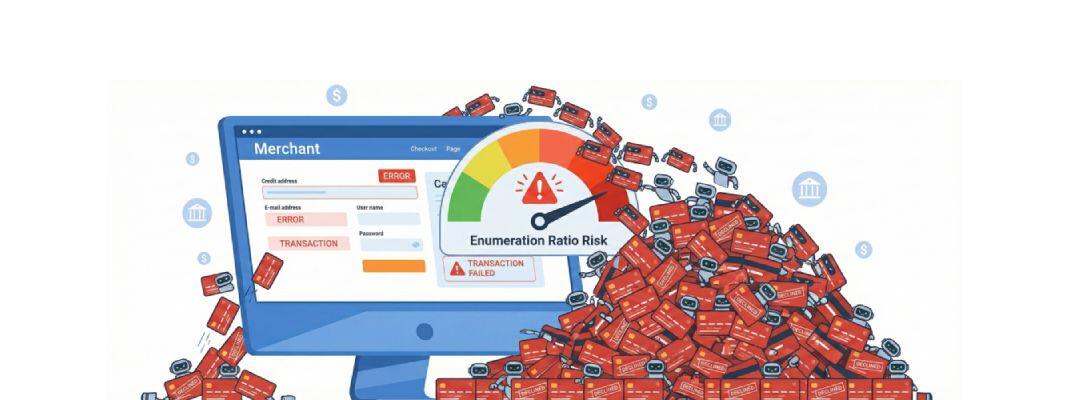If you accept Visa payments, understanding VAMP isn't optional; it's essential to ensure the long-term stability and cost-effectiveness of your merchant account.
Section 1: VAMP: The New Unified Metric (and the Double-Count)
The Visa Acquirer Monitoring Program (VAMP) consolidated the previous separate monitoring systems (the Visa Fraud Monitoring Program and the Visa Dispute Monitoring Program) into a single, unified framework. The core of VAMP is a new metric: the VAMP Ratio.
The program’s most significant change is that it combines both types of payment risk—fraud and customer disputes—into one percentage:
This change, however, carries a hidden risk: The Double-Count. Because a fraudulent transaction often results in both a fraud report (TC40) and a dispute (TC15), many risk events are effectively counted twice against your ratio. This means a merchant’s ratio can climb much faster under VAMP than under the old system, accelerating their entry into a high-risk category.
VAMP Thresholds at a Glance
| Status | Merchant Ratio Limit | Acquirer Portfolio Ratio Limit |
|---|---|---|
| Above Standard | — | ≥ 0.3% |
| Excessive | 1.5% (drops to 0.9% in 2026) | ≥ 0.5% |
Section 2: The Acquirer's Squeeze: VAMP Compliance and the Strict Merchant Account Thresholds
This is the most critical component of VAMP for merchants, and it's where the comparison of merchant accounts becomes vital.
VAMP's name tells you its true target: the Acquirer (your bank or payment processor). Visa’s ultimate goal is to enforce a low, collective risk average across the entire portfolio of every Acquirer.
The Acquirer's Core Problem:
- Visa’s Merchant Limit: A merchant is officially considered "Excessive" by Visa when their VAMP ratio hits 1.5% (dropping to a strict 0.9% in 2026).
- Visa’s Acquirer Limit: The Acquirer’s portfolio must maintain an average VAMP ratio of 0.5%, with compliance standards tightening to 0.3% in 2026.
The Trickle-Down Effect:
To keep their overall portfolio average below 0.5% (and eventually 0.3%), Acquirers simply cannot afford to sponsor a merchant running at 0.9%. If just a few merchants breach the 0.5% mark, it jeopardizes the Acquirer's compliance status, risking massive fines from Visa.
This forces payment processors to impose internal, unpublished VAMP thresholds on their merchants that are significantly lower than Visa’s official limits.
The Reality: A merchant with a VAMP ratio of 0.7% may technically be safe under Visa’s 0.9% limit, but they are a massive liability to an Acquirer whose portfolio average must be under 0.5%. This merchant is highly likely to be flagged, face sudden fee increases, be placed in a monitoring program, or even have their account terminated without warning—all in the name of the Acquirer protecting their compliance standing with Visa.
The hidden cost of compliance is the risk of account termination and the resulting scramble to find a new, potentially high-risk processor.
Section 3: The Threat Beyond Chargebacks: Card Testing and Enumeration
VAMP introduced a separate, critical metric aimed at combating sophisticated digital fraud: Enumeration Monitoring.
- What is Enumeration? This is often referred to as "card testing." It's when fraudsters use bots or scripts to test a massive number of stolen or generated card numbers on your checkout page via rapid, small-value transactions.
- The VAMP Impact: Under VAMP, your risk profile is now damaged by this activity, even if the transactions are ultimately declined. Visa's system tracks the percentage of authorized and declined transactions that are confirmed to be enumeration attempts.
- The Threshold: If your business exceeds 300,000 confirmed enumerated transactions and an enumeration ratio of 20%, you enter the monitoring program. This puts a huge emphasis on advanced front-end fraud tools to stop card testing before it ever hits the network.
Section 4: VAMP vs. ECP: How Visa and Mastercard Differ
For any business comparing payment processing options, understanding how VAMP stacks up against its Mastercard equivalent, the Excessive Chargeback Program (ECP), is crucial:
| Feature | Visa VAMP (Acquirer Monitoring Program) | Mastercard ECP (Excessive Chargeback Program) |
|---|---|---|
| Metrics Tracked | Fraud (TC40) and Disputes (TC15) | Chargebacks only |
| Goal | Unified risk management; stricter oversight on Acquirers. | Focus on reducing excessive chargeback volume. |
| Merchant Threshold | Starts at 1.5% (dropping to 0.9% in 2026) | Starts at 1.5% for ECM tier; 3.0% for HECM tier. |
| Penalty Structure | Fee per incident/transaction (usually $10). Penalties scale with volume. | Flat, escalating monthly fines. Penalties scale with time. |
| Compliance Time | Enforcement is often faster; no grace period once identified. | Typically requires two consecutive months to trigger. |
Section 5: Protect Your Account: 4 Essential Questions to Ask Your Processor
To protect your merchant account stability in the VAMP era, you must select a processor who is actively managing their portfolio risk and providing the tools you need.
Use these four questions to vet any potential Acquirer or Payment Service Provider:
- "What is your internal, non-negotiable VAMP ratio threshold for merchants in my industry?"
- Why this matters: Do not accept Visa's public limits (0.9%). Get a number closer to the Acquirer's internal comfort level (often 0.7% or lower) to know where your true danger zone lies.
- "Do you provide VAMP-compliant prevention tools (like Order Insight, RDR, or alerts) as part of your standard service, or are they an add-on?"
- Why this matters: Tools that resolve disputes before they become chargebacks (like Rapid Dispute Resolution - RDR) are essential for compliance. You need a processor that integrates these solutions directly.
- "How quickly can I access my TC40 and TC15 data to calculate my true VAMP ratio?"
- Why this matters: If your processor doesn't provide real-time or near-real-time access to the exact data Visa uses, you are flying blind until it's too late.
- "What specific anti-enumeration tools do you have in place to protect me from the VAMP enumeration component?"
- Why this matters: You need more than basic fraud filters. Ask about AI-based systems or velocity checks that specifically detect card-testing bots, even on declined transactions.
Conclusion
VAMP signals a new, stricter era of payments compliance. The burden is no longer just on the merchant to manage chargebacks; it’s on the Acquirer to manage their entire risk portfolio. By understanding the low thresholds your processor is operating under and asking the right questions up front, you can ensure your merchant account remains stable and avoid the costly consequences of sudden termination.




